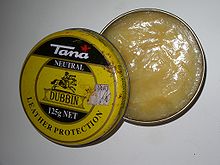Dubbin (also known as "dubbing" in the US) is a greasy or waxy product used to soften, condition, and waterproof leather. It has been used since medieval times to waterproof and soften leather goods.[1] It differs from saddle soap used to clean and lightly condition leather, or shoe polish, which is used to impart shine and colour to it.

It consists primarily of various waxes and oils. Commercial dubbin contains petroleum jelly (petrolatum), paraffin wax, neatsfoot oil, and naphtha (C10-12 alkane/cycloalkane).[2] More traditional dubbin can be made with beeswax; fish oil; and lard.[3]
The name dubbin is a contraction of the gerund dubbing, describing the action of applying the wax to leather.[4]
References edit
- Citations
- ^ Waterer, John William (1981). Leather and the warrior : an account of the importance of leather to the fighting man from the time of the ancient Greeks to World War II. Northampton, England: The Museum of Leathercraft. p. 61. ISBN 978-0950418216.
- ^ "Kiwi Dubbin Neutral". Archived from the original on 15 September 2023.
- ^ "Mad Madam Mel: A recipe for Dubbin". madmadammel.com. Retrieved 2 September 2016.
- ^ "dub1". askoxford.com. Archived from the original on 23 September 2004. Retrieved 15 April 2010.
- Other references
- [1] – Material Safety Data Sheet – Joseph Lyddy dubbin.
- [2] – Opportunities for industry and the safe investment of capital (1859) Rothman, E., Lippincott, US
- Jarell, T.D., Holman, H.P., (1923) Effects of Treating Materials and Outdoor Exposure upon Water Resistance and Tensile Strength of Cotton Duck, Industrial and Engineering Chemistry, Bureau of Chemistry, Washington.
- Norton, F.J., (1945) Waterproofing Treatments of Materials, Patent Number 2386259, Serial Number 452,885, United States Patent Office.
- Holman, H.P., Jarrell, T.D., (date unknown) The Effects of Waterproofing Materials and Outdoor Exposure upon the Tensile Strength of Cotton Yarn, Industrial and Engineering Chemistry, 15(3), US Department of Agriculture, Washington.
- Stewart, C.S., (1977) Factors Affecting the Cellulolytic Activity of Rumen Contents, Applied and Environmental Microbiology, pp. 497–502